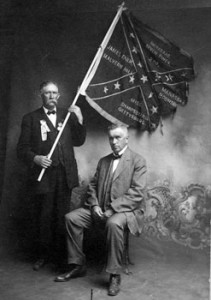
Prof. William Irvin Gibson (seated) served with the 2nd Regiment, Mississippi Infantry during the Civil War. Gibson served as president of Burleson College in Greenville. Later Gibson taught Greek and Latin at the school. This photograph may have been taken during the Confederate Veterans Reunion in Greenville. The man holding the flag is not identified.
One hundred years old Greenville was inundated with thousands of older gentlemen, the vast majority of whom were Confederate veterans of the Civil War. For the second year in a row, the city hosted the Texas Confederate Veteran Reunion.
Most of the gentlemen were into their seventies, maybe even a few in their late eighties or early nineties. The favored mode of transportation was by train since Greenville was a large railroad hub in the state at that time. The weather was hot; after all it was July 30-31. Amazingly the Confederate veterans camped out in tents and slept on cots for three nights and two days. The War Department of the Federal government shipped fifty tents from St. Louis at the request of Texas Senator Morris Sheppard. The local Chamber of Commerce purchased 600 folding cots when the War Department could not provide them. Newspapers reported at least 1,000 veterans participated.
The site of this vast campground was the old Hunt County Fair Grounds according to newspaper reports of the day. That was located along Long Branch Creek between Moulton and Stonewall Streets. A hospital tent was set up but it seems the only patients were those who had too much sun. Remember, folks around here prior to the 1950s didn’t have air conditioning.
Even though 1914 was an election year for state offices, the primary elections were held earlier in the week. In Texas politics at that time, the primary basically decided the vote and the election in November was only a formality. There had been a lot of political campaigning here in Hunt County, but now everyone was anxious to visit with the gentlemen and hear their stories. Surely one interesting attendee was T. M. Finley (1840-1931) of Greenville. This gentleman was not a Confederate veteran, instead he served as an artillery captain in the Union army. His battalion had fired the salute at Lincoln’s second inaugural ceremony and guarded the bridge near the barn where John Wilkes Boothe hid after the Lincoln assassination. Business interests caused Finley and his wife to relocate to Greenville in the 1880s. He was a very personable person who quickly fit in with local society. Soon he became an associate member of the Confederate Veterans Associations.
The highlight of the reunion came the first day when former U. S. Senator J. W. Bailey gave the principal address with seven to eight thousand persons in attendance. Bailey was feted the evening before at the home of Mr. and Mrs. Will N. Harrison. The home at the southwest corner of Park and Moulton Streets was as festive as Park Street was for the Fourth of July this year. In fact, bunting and flags were displayed throughout town.
Ironically, Greenville and Hunt County citizens were not staunch secession supporters. The vote to secede barely passed here. Men did ride off with Confederate units, but some supported the Union cause and fled to Arkansas to join the U. S. Army. After the war this entire area was caught up in a brutal battle between former Confederates, Unionists, former slaves, and the U. S. Army. The aftermath seems to have converted many to the Lost Cause.
